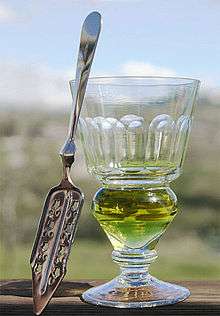Lucid Absinthe
| Type | Absinthe |
|---|---|
| Manufacturer | Hood River Distillers |
| Country of origin | France |
| Introduced | 2007 in United States |
| Alcohol by volume | 62.0% |
| Proof (US) | 124 |
Lucid Absinthe Supérieure is the first genuine absinthe made with real Grande Wormwood to be legally available in the United States after the repeal of the 95-year ban.
Lucid is distilled in accordance with traditional French methods, in the historic Combier Distillery (Loire Valley, France), founded in 1834 and designed by Gustave Eiffel. Lucid is distilled entirely from spirits and European whole herbs and uses no artificial additives, oils, or dyes.[1]
History
Allegedly created as an elixir in the 1790s by Dr. Pierre Ordinaire of Switzerland, absinthe became so popular in bars, bistros, cafés, and cabarets that, by the 1860s, the 5 p.m. happy hour was called l'heure verte ("the green hour"). By 1910, the French were drinking 36 million liters of absinthe per year, as compared to their annual consumption of almost 5 billion liters of wine.[2] As a result, the winemakers association, among other groups, began a campaign of misinformation that tied consuming absinthe to claims of insanity, criminal activity and hallucinations – all designed to discourage consumption. These claims were aided by the fact that unlike Cognac, champagne, etc., there was no law that defined absinthe – nothing to regulate the production and quality. In 1912, the U.S. Department of Agriculture banned absinthe in the United States, and it was banned in France a few years later.[3]
After 95 years of prohibition, genuine absinthe was re-authorized for sale in the United States with the approval of Lucid in 2007. Lucid creator and scientist T.A. Breaux negotiated with the U.S. government on the basis that Lucid was created from absinthe-making techniques used over a century ago, and the result was not only a genuine, historically accurate product, but one that met all requirements from the U.S. Alcohol and Tobacco Tax and Trade Bureau mandate that any finished food or beverage tests less than 10ppm or 10 mg/kg - well under the 35 mg/kg content that is legal within the European Union - for Thujone, pursuant to 21 CFR 172.510.[4] The Lucid brand revived the antique term "Absinthe Supérieure" to differentiate itself from the negative connotations of absinthe that persisted in the TTB.[5]
Lucid was granted a COLA (Certificate of Label Approval) in the United States on March 5, 2007,[6][7] making it the first genuine absinthe to gain approval for legal distribution in the U.S. since 1912.
Lucid was produced for Viridian Spirits, LLC, New York before being sold to Hood River Distillers in 2013.[8][9]
Botanicals Used
Lucid is distilled entirely from all natural ingredients and is the first genuine absinthe distilled with real Grande Wormwood (Artemisia absinthium) available in the United States in more than 95 years. Lucid is made with historically accurate volumes of Grande Wormwood, as well as other botanicals, such as green anise and sweet fennel that are traditional to the spirit. The recipe was developed by T.A. Breaux, an absinthe expert and historian.[10][11] Lucid’s green color is derived directly from the botanicals, without any artificial coloring added – a key feature of genuine absinthe. Lucid’s natural color requires a dark bottle because exposure to light will cause the natural color to fade, which explains why so many traditional absinthes were bottled in dark glass.
Taste Profile
Lucid is characterized by upfront flavors of anise and fennel, followed by mild mid-palate earthy textures attributable to the absinthe (Artemisia absinthium). The herbs round out the flavor with additional spice and grassy notes, which linger in a moderately long finish.[12]
Proof
Lucid is 124 proof or 62% alcohol/volume.
Notes
- ↑ The Spirit World - » Lucid Absinthe
- ↑ New York Times. High Price of Wines due to Short Crops. 1911-11-05. Retrieved 2008-10-20. "1910, was no less than 1,089 millions of gallons." ... "162 bottles per head" (gallons assumed to be Imperial, despite the American source, because 162 times population at 1901 census of 40,681,415 times a 75cl bottle equals 1087 million Imperial gallons, or 4942 million litres. Wine consumption dropped markedly in 1911 to about 111 bottles per person due to a 30% drop in the 1910 vintage yield)
- ↑ "Authentic Absinthe Is Legal In The US". The Wormwood Society. Retrieved 31 August 2016.
- ↑ Alcohol Tax and Trade Bureau Industry Circular Number 2007-5. Retrieved 5 March 2008. Archived 11 February 2008 at the Wayback Machine.
- ↑ LaMotta, Lisa (2007). "Wrestling With Regulators". Forbes Magazine. Archived from the original on 11 October 2007. Retrieved 2007-09-25.
- ↑ Tax and Trade Bureau (2007). "Certificate of Label Approval, Lucid Absinthe Supérieure". U.S. Alcohol & Tobacco Tax & Trade Bureau (TTB).
- ↑ The Spirit World - » Lucid Absinthe
- ↑ http://www.drinklucid.com/pdf/nytimes_04-29-07.pdf
- ↑ Theakson, Rob. "Hood River Acquires Lucid Absinthe". Drinkhacker. Retrieved 31 August 2016.
- ↑ Absinthe Feels So Good When It Hits the U.S. Market - Grub Street - New York Magazine
- ↑ "Wired 13.11: The Mystery of the Green Menace". Wired.
- ↑ "Absinthe and Fruit: This summer's hottest cocktail trends". The Paramus Post. Retrieved 31 August 2016.
